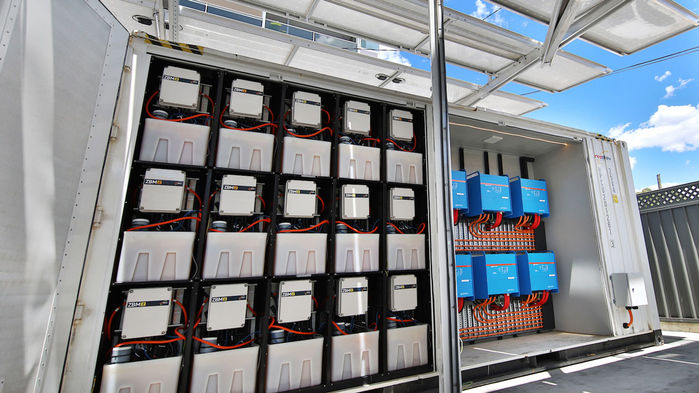
Batteries already power electronics, tools, and cars; soon, they could help sustain the entire electric grid. With the rise of wind and solar power, energy companies are looking for ways to keep electrons flowing when the sun doesn’t shine and the wind ebbs. Giant devices called flow batteries, using tanks of electrolytes capable of storing enough electricity to power thousands of homes for many hours, could be the answer. But most flow batteries rely on vanadium, a somewhat rare and expensive metal, and alternatives are short-lived and toxic.
Last week, researchers reported overcoming many of these drawbacks with a potentially cheap, long-lived, and safe flow battery. The work is part of a wave of advances generating optimism that a new generation of flow batteries will soon serve as a backstop for the deployment of wind and solar power on a grand scale. “There is lots of progress in this field right now,” says Ulrich Schubert, a chemist at Friedrich Schiller University in Jena, Germany.
Lithium-ion batteries—the sort in laptops and Teslas—have a head start in grid-scale applications. Lithium batteries already bank backup power for hospitals, office parks, and even towns. But they don’t scale up well to the larger sizes needed to provide backup power for cities, says Michael Perry, associate director for electrochemical energy systems at United Technologies Research Center in East Hartford, Connecticut.
That’s where flow batteries come in. They store electrical charge in tanks of liquid electrolyte that is pumped through electrodes to extract the electrons; the spent electrolyte returns to the tank. When a solar panel or turbine provides electrons, the pumps push spent electrolyte back through the electrodes, where the electrolyte is recharged and returned to the holding tank. Scaling up the batteries to store more power simply requires bigger tanks of electrolytes. Vanadium has become a popular electrolyte component because the metal charges and discharges reliably for thousands of cycles. Rongke Power, in Dalian, China, for example, is building the world’s largest vanadium flow battery, which should come online in 2020. The battery will store 800 megawatt-hours of energy, enough to power thousands of homes. The market for flow batteries—led by vanadium cells and zinc-bromine, another variety—could grow to nearly $1 billion annually over the next 5 years, according to the market research firm MarketsandMarkets.
But the price of vanadium has risen in recent years, and experts worry that if vanadium demand skyrockets, prices will, too. A leading alternative replaces vanadium with organic compounds that also grab and release electrons. Organic molecules can be precisely tailored to meet designers’ needs, says Tianbiao Liu, a flow battery expert at Utah State University in Logan. But organics tend to degrade and need replacement after a few months, and some compounds work only with powerful acidic or basic electrolytes that can eat away at the pumps and prove dangerous if their tanks leak.
Researchers are now in the midst of “a second wave of progress” in organic flow batteries, Schubert says. In July, a group led by Harvard University materials scientist Michael Aziz reported in Joule that they had devised a long-lived organic molecule that loses only 3% of its charge-carrying capacity per year. Although that’s still not stable enough, it was a big jump from previous organic flow cell batteries that lost a similar amount every day, Liu says.
Iron, which is cheap and good at grabbing and giving up electrons, is another promising alternative. A Portland, Oregon, company called EES, for example, sells such batteries. But EES’s batteries require electrolytes operating at a pH between one and four, with acidity similar to vinegar’s.
Now, Liu and his colleagues have come up with a flow battery that operates at neutral pH. They started with an iron-containing electrolyte, ferrocyanide, that has been studied in the past. But in previous ferrocyanide batteries, the electrolyte was dissolved in water containing sodium or potassium salts, which provide positively charged ions that move through the cell to balance the electron movement during charging and discharging. Ferrocyanide isn’t very soluble in those salt solutions, limiting the electrical storage capacity of the battery.
So Liu and his colleagues replaced the salts with a nitrogen-based compound called ammonium that allows at least twice as much ferrocyanide to dissolve, doubling the battery’s capacity. The resulting battery is not as energy-dense as a vanadium flow battery. But in last week’s issue of Joule, Liu and his colleagues reported that their iron-based organic flow battery shows no signs of degradation after 1000 charge-discharge cycles, equivalent to about 3 years of operation. And because the electrolytes are neutral pH and water-based, a leak likely wouldn’t produce environmental damage.
“Overall, that’s an excellent piece of work,” says Qing Wang, a materials scientist at the National University of Singapore. Still, he and others caution that the battery is sluggish to charge and discharge. Liu says he and his colleagues plan to test other electrolyte additives, among other fixes, to boost conductivity.
It’s too early to say which flow battery chemistry—if any—will support the renewable grid of the future. Another contender uses electrolytes made from metal-containing organic compounds called polyoxometalates, which store far more energy in the same volume than the competition. In the 10 October issue of Nature Chemistry, for example, researchers led by Leroy Cronin, a chemist at the University of Glasgow in the United Kingdom, reported a polyoxometalate flow battery that stores up to 40 times as much charge as vanadium cells of the same volume. The downside for now is that these electrolytes are highly viscous and thus more challenging to pump through the battery, Cronin says. “Today, no one flow battery fills all the needs,” Schubert says. That means there’s still plenty of room for innovation.
